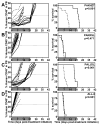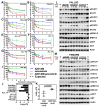Evaluation of the in vitro and in vivo efficacy of the JAK inhibitor AZD1480 against JAK-mutated acute lymphoblastic leukemia
- PMID: 25504635
- PMCID: PMC4326541
- DOI: 10.1158/1535-7163.MCT-14-0647
Evaluation of the in vitro and in vivo efficacy of the JAK inhibitor AZD1480 against JAK-mutated acute lymphoblastic leukemia
Abstract
Genome-wide studies have identified a high-risk subgroup of pediatric acute lymphoblastic leukemia (ALL) harboring mutations in the Janus kinases (JAK). The purpose of this study was to assess the preclinical efficacy of the JAK1/2 inhibitor AZD1480, both as a single agent and in combination with the MEK inhibitor selumetinib, against JAK-mutated patient-derived xenografts. Patient-derived xenografts were established in immunodeficient mice from bone marrow or peripheral blood biopsy specimens, and their gene expression profiles compared with the original patient biopsies by microarray analysis. JAK/STAT and MAPK signaling pathways, and the inhibitory effects of targeted drugs, were interrogated by immunoblotting of phosphoproteins. The antileukemic effects of AZD1480 and selumetinib, alone and in combination, were tested against JAK-mutated ALL xenografts both in vitro and in vivo. Xenografts accurately represented the primary disease as determined by gene expression profiling. Cellular phosphoprotein analysis demonstrated that JAK-mutated xenografts exhibited heightened activation status of JAK/STAT and MAPK signaling pathways compared with typical B-cell precursor ALL xenografts, which were inhibited by AZD1480 exposure. However, AZD1480 exhibited modest single-agent in vivo efficacy against JAK-mutated xenografts. Combining AZD1480 with selumetinib resulted in profound synergistic in vitro cell killing, although these results were not translated in vivo despite evidence of target inhibition. Despite validation of target inhibition and the demonstration of profound in vitro synergy between AZD1480 and selumetinib, it is likely that prolonged target inhibition is required to achieve in vivo therapeutic enhancement between JAK and MEK inhibitors in the treatment of JAK-mutated ALL.
©2014 American Association for Cancer Research.
Conflict of interest statement
M. Loh served on an Advisory Board for Novartis to discuss the possible role of JAK inhibition in childhood leukemia. The remaining authors disclose no potential conflicts of interest.
Figures





Similar articles
-
Antiangiogenic and antimetastatic activity of JAK inhibitor AZD1480.Cancer Res. 2011 Nov 1;71(21):6601-10. doi: 10.1158/0008-5472.CAN-11-1217. Epub 2011 Sep 15. Cancer Res. 2011. PMID: 21920898 Free PMC article.
-
Inhibition of STAT3 with orally active JAK inhibitor, AZD1480, decreases tumor growth in Neuroblastoma and Pediatric Sarcomas In vitro and In vivo.Oncotarget. 2013 Mar;4(3):433-45. doi: 10.18632/oncotarget.930. Oncotarget. 2013. PMID: 23531921 Free PMC article.
-
Efficacy of JAK/STAT pathway inhibition in murine xenograft models of early T-cell precursor (ETP) acute lymphoblastic leukemia.Blood. 2015 Mar 12;125(11):1759-67. doi: 10.1182/blood-2014-06-580480. Epub 2015 Feb 2. Blood. 2015. PMID: 25645356 Free PMC article.
-
The biology of Philadelphia chromosome-like ALL.Best Pract Res Clin Haematol. 2017 Sep;30(3):212-221. doi: 10.1016/j.beha.2017.07.003. Epub 2017 Jul 6. Best Pract Res Clin Haematol. 2017. PMID: 29050694 Review.
-
How is the Ph-like signature being incorporated into ALL therapy?Best Pract Res Clin Haematol. 2017 Sep;30(3):222-228. doi: 10.1016/j.beha.2017.06.001. Epub 2017 Jun 15. Best Pract Res Clin Haematol. 2017. PMID: 29050695 Free PMC article. Review.
Cited by
-
Case Report: Precision Medicine Target Revealed by In Vitro Modeling of Relapsed, Refractory Acute Lymphoblastic Leukemia From a Child With Neurofibromatosis.Front Oncol. 2022 Apr 20;12:851572. doi: 10.3389/fonc.2022.851572. eCollection 2022. Front Oncol. 2022. PMID: 35515133 Free PMC article.
-
Acute Sensitivity of Ph-like Acute Lymphoblastic Leukemia to the SMAC-Mimetic Birinapant.Cancer Res. 2016 Aug 1;76(15):4579-91. doi: 10.1158/0008-5472.CAN-16-0523. Epub 2016 Jun 14. Cancer Res. 2016. PMID: 27302164 Free PMC article.
-
A review of new agents evaluated against pediatric acute lymphoblastic leukemia by the Pediatric Preclinical Testing Program.Leukemia. 2016 Nov;30(11):2133-2141. doi: 10.1038/leu.2016.192. Epub 2016 Jul 15. Leukemia. 2016. PMID: 27416986 Review.
-
Clinical diagnostics and treatment strategies for Philadelphia chromosome-like acute lymphoblastic leukemia.Blood Adv. 2020 Jan 14;4(1):218-228. doi: 10.1182/bloodadvances.2019000163. Blood Adv. 2020. PMID: 31935290 Free PMC article. Review.
-
Co-targeting of the thymic stromal lymphopoietin receptor to decrease immunotherapeutic resistance in CRLF2-rearranged Ph-like and Down syndrome acute lymphoblastic leukemia.Leukemia. 2025 Mar;39(3):555-567. doi: 10.1038/s41375-024-02493-3. Epub 2024 Dec 16. Leukemia. 2025. PMID: 39681640 Free PMC article.
References
-
- Harvey RC, Mullighan CG, Wang X, Dobbin KK, Davidson GS, Bedrick EJ, et al. Identification of novel cluster groups in pediatric high-risk B-precursor acute lymphoblastic leukemia with gene expression profiling: correlation with genome-wide DNA copy number alterations, clinical characteristics, and outcome. Blood. 2010;116:4874–84. - PMC - PubMed
-
- Harvey RC, Mullighan CG, Chen IM, Wharton W, Mikhail FM, Carroll AJ, et al. Rearrangement of CRLF2 is associated with mutation of JAK kinases, alteration of IKZF1, Hispanic/Latino ethnicity, and a poor outcome in pediatric B-progenitor acute lymphoblastic leukemia. Blood. 2010;115:5312–21. - PMC - PubMed
Publication types
MeSH terms
Substances
Grants and funding
- CA98543/CA/NCI NIH HHS/United States
- CA114766/CA/NCI NIH HHS/United States
- N01 CM042216/CA/NCI NIH HHS/United States
- U01 CA157937/CA/NCI NIH HHS/United States
- U10 CA098543/CA/NCI NIH HHS/United States
- U01 CA199297/CA/NCI NIH HHS/United States
- CA98413/CA/NCI NIH HHS/United States
- U10 CA180886/CA/NCI NIH HHS/United States
- N0I-CM-42216/CM/NCI NIH HHS/United States
- U10 CA098413/CA/NCI NIH HHS/United States
- U24 CA114766/CA/NCI NIH HHS/United States
- N0I-CM-91001-03/CM/NCI NIH HHS/United States
- N01 CM042216/CM/NCI NIH HHS/United States
LinkOut - more resources
Full Text Sources
Other Literature Sources
Molecular Biology Databases
Research Materials
Miscellaneous

